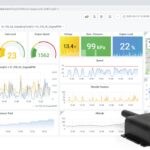Vehicle diagnostics have never been easier thanks to advancements in automotive technology. For car owners and DIY enthusiasts, understanding your vehicle’s health is now at your fingertips with Bosch Obd2 Bluetooth scanners. These innovative tools transform your smartphone into a powerful diagnostic device, providing instant insights into your car’s performance and potential issues. Say goodbye to confusing check engine lights and expensive trips to the mechanic – Bosch brings professional-grade diagnostics right to your garage with the convenience of Bluetooth connectivity.
Understanding what’s happening under the hood is crucial for vehicle maintenance and longevity. The Check Engine Light, that dreaded symbol on your dashboard, often signals complex problems that are difficult to decipher without the right tools. This is where Bosch OBD2 Bluetooth scanners step in, offering a user-friendly solution to demystify your vehicle’s diagnostic codes. By simply plugging a small adapter into your car’s OBD2 port and connecting via Bluetooth to your smartphone, you gain access to a wealth of information about your vehicle’s health.
The Power of OBD2 and Bluetooth in Vehicle Diagnostics
OBD2 (On-Board Diagnostics II) is a standardized system in most cars and light trucks manufactured since 1996. It monitors various vehicle systems, from engine performance to emissions, and generates Diagnostic Trouble Codes (DTCs) when it detects an issue. Traditionally, accessing this information required specialized and often costly scan tools. However, Bosch OBD2 Bluetooth technology has revolutionized this process.
Bluetooth connectivity eliminates the need for cumbersome wires and allows for seamless communication between your vehicle and your smartphone. This wireless convenience, combined with Bosch’s expertise in automotive diagnostics, provides a potent tool for anyone wanting to understand their car better. Whether you’re a seasoned mechanic or a first-time car owner, Bosch OBD2 Bluetooth scanners empower you to take control of your vehicle’s maintenance.
Key Features of Bosch OBD2 Bluetooth Mobile Scan Tools
Bosch, a trusted name in automotive parts and diagnostics, offers user-friendly OBD2 Bluetooth scanners designed for ease of use and comprehensive vehicle insights. These tools, often paired with intuitive mobile apps, provide a range of features, including:
- Quick Diagnostic Checks: Perform rapid scans to identify the cause of a check engine light, understand emissions status, and read crucial DTCs. Bosch’s QuickCheck™ feature provides a summary of vehicle health in moments.
- DTC Reading and Definition: Not only do these scanners read the Diagnostic Trouble Codes, but they also provide clear, easy-to-understand definitions. No more cryptic codes – Bosch helps you understand exactly what the issue is.
- Check Engine Light Reset: Once you’ve addressed the issue causing the check engine light, Bosch OBD2 Bluetooth scanners allow you to reset the light, confirming the problem is resolved.
- Emissions Readiness (I/M Monitors): Check your vehicle’s emissions system status to ensure it will pass emissions tests. This is crucial for legal compliance and environmental responsibility.
- Enhanced Powertrain Data: Delve deeper into engine-related issues with access to powertrain-specific DTCs and definitions for a wide range of vehicle manufacturers. Get manufacturer-level insights for brands like GM, Ford, Chrysler, Honda, Toyota, and more.
- Live Data Streaming: Monitor real-time vehicle parameters like RPM, coolant temperature, oxygen sensor readings, and more. This live data feature is invaluable for diagnosing intermittent issues and understanding engine performance under various conditions. (Note: Live Data should be used when the vehicle is stationary for safety).
- Freeze Frame Data: Capture a snapshot of vehicle conditions at the exact moment a DTC was triggered. This “freeze frame” of data provides valuable context for diagnosing the root cause of the problem.
- Extensive Code Database (CodeConnect®): Access a vast database of verified fixes (like CodeConnect®) compiled by ASE-certified technicians. This feature can significantly speed up the repair process by suggesting the most likely solutions for specific DTCs related to check engine, ABS, and Airbag lights.
- ABS and Airbag System Diagnostics: Go beyond engine codes and read and clear DTCs related to ABS (Anti-lock Braking System) and Airbag/SRS (Supplemental Restraint System) warning lights on many vehicle models.
Simple Steps to Use Your Bosch OBD2 Bluetooth Scanner
Getting started with Bosch OBD2 Bluetooth diagnostics is remarkably straightforward:
- Download the Bosch Mobile Scan App: Find the free Bosch Mobile Scan app on the Google Play Store for Android devices or the Apple App Store for iPhones.
- Connect the Adapter: Locate your vehicle’s OBD2 port, typically found under the steering column. Plug the Bosch OBD2 Bluetooth adapter into this port.
- Pair and Diagnose: Open the Bosch Mobile Scan app on your smartphone and follow the on-screen instructions to establish a Bluetooth connection with the adapter. Once connected, you can begin scanning your vehicle for diagnostic information.
Conclusion: Empowering Vehicle Owners with Bosch OBD2 Bluetooth
Bosch OBD2 Bluetooth scanners are transforming vehicle diagnostics, making it accessible, affordable, and user-friendly for everyone. By combining the power of OBD2 technology with the convenience of Bluetooth connectivity and Bosch’s automotive expertise, these tools empower vehicle owners to understand their cars better, troubleshoot issues effectively, and potentially save money on repairs. Whether you are proactively monitoring your vehicle’s health or reacting to a warning light, a Bosch OBD2 Bluetooth scanner is an invaluable tool for modern car maintenance. Take control of your car’s diagnostics and experience the peace of mind that comes with understanding your vehicle inside and out.
